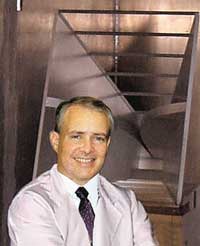
 |
Personality Profile |
Bill Duff, Associate Editor |
 |
Larry at work in his Advanced Technology Chamber (Mode Stirred) at the Naval Research Lab. |
Larry Cohen, a native Washingtonian, was born on December 20, 1948. He grew up in the Silver Spring, Maryland area. Larry put himself through college at George Washington University by working as an auto parts salesman at a nearby Sears and Roebuck. He graduated with a BSEE in 1975. Larry served for six years with the Maryland Army National Guard which included six months active duty training as an infantry soldier at Fort Polk, Louisiana.
Upon graduation from GWU, Larry went to work for the Naval Ship Engineering Center (NAVSEC) in Hyattsville, Maryland where he was involved with the design of the Combat Suite for the SSN-688 Class attack submarines. By 1978, NAVSEC had merged with the Naval Sea Systems Command (NAVSEA) where Larry went to work in the Topside Antenna Integration Group for Preston Law. This was Larry's introduction to the pandemic problems caused by electromagnetic radiation on a ship's topsides and the importance of good EMC practices. During his tenure in the Topside Integration Group Larry was responsible for the arrangement of antennas and EMC for amphibious, auxiliary and destroyer classes of ships. Larry was mentored by Preston Law, Jim Garrett and Dick Ford in attempting to optimize antenna performance against the backdrop of EMC and structural considerations.
By 1986, Larry became deeply involved in the use of radar absorption material (RAM) in order to mitigate problems involving reflections of RF energy on a ship's topsides. During this time, Dick Ford invited Larry to apply for employment at the Naval Research Laboratory (NRL) in Washington, DC. Larry began his service at NRL on April 1, 1987 working for Dick Ford. Larry decided that working at NRL required additional technical insight so he enrolled in the Masters program in Electrical Engineering at the Virginia Polytechnic Institute and State University, specializing in communications theory and signal processing. Larry became heavily involved in the design of RAM for shipboard EMC applications. With Dick Ford, Larry performed isolation testing as part of the UAV Pioneer Program, with RAM aboard the Battleship USS Iowa.
During this time Larry began his association with Professor Jose Perini of Syracuse University. Professor Perini provided Larry with technical insight on how RAM performance could be optimized for angle of incidence and frequency considerations. As a result of this effort Larry played a significant role in the development of a numerical model that allowed optimization of RAM design parameters as well as a RAM specification for NAVSEA.
In 1993, Dick Ford became interested in Mode Stirred Chamber technology and directed Larry to secure funding for a chamber to be built at NRL. Larry spent the next three years investigating ways of optimizing chamber test performance.
In April of 1994 Larry received his MSEE from Virginia Tech.
In 1997, a result of the Navy's interest in active array technology, Larry became interested in potential EMI related problems, including the generation of intermodulation products, as a result of the use of transmit/receive (T/R) modules which populate active array antennas. Larry gave a series of talks alerting the DOD EMC community on potential problems that could result through the use of T/R modules.
During the 1987-1997 time period, Larry was afforded the opportunity to represent US Navy EMC interests at various international meetings and forums. He was appointed by Steve Caine of SPAWAR as a US Navy representative to the Information Exchange with the UK Royal Navy.
For the past three years Larry has continued work on mode stirred chambers investigating the use of non-mechanical electronic methods for stirring modes. Larry has recently been involved with assessing the EMI related effects between US Navy shipboard radars and wireless communications.
In 1999, Larry was elected to the EMC Society Board of Directors and was the Technical Program Chairman for the 2000 IEEE International Symposium on EMC held in Washington, DC.
In his spare time Larry enjoys playing golf, bicycling, hiking and reading. EMC